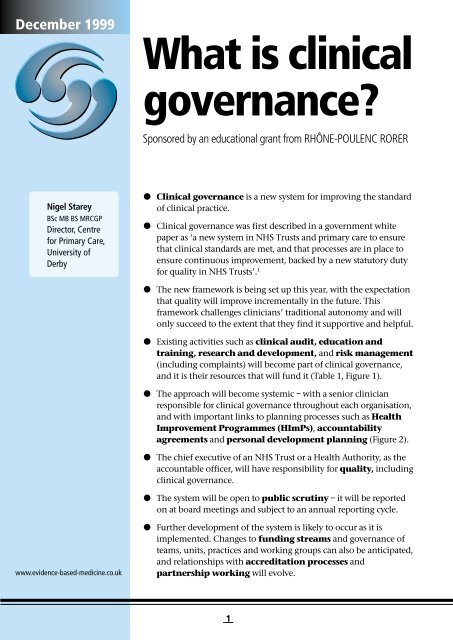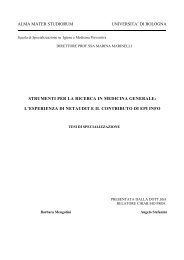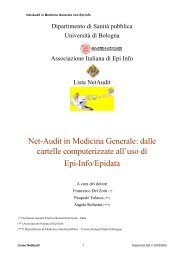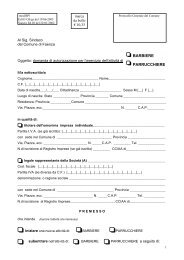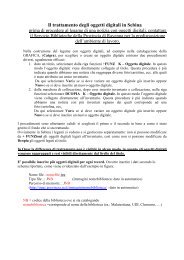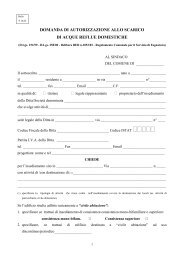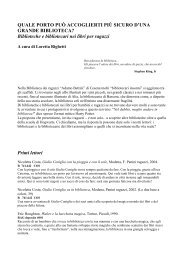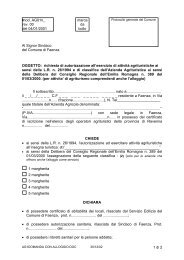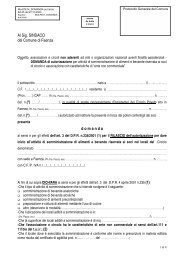What is clinical governance? - R@cine
What is clinical governance? - R@cine
What is clinical governance? - R@cine
Create successful ePaper yourself
Turn your PDF publications into a flip-book with our unique Google optimized e-Paper software.
December 1999<br />
<strong>What</strong> <strong>is</strong> <strong>clinical</strong><br />
<strong>governance</strong>?<br />
Sponsored by an educational grant from RHÔNE-POULENC RORER<br />
Nigel Starey<br />
BSc MB BS MRCGP<br />
Director, Centre<br />
for Primary Care,<br />
University of<br />
Derby<br />
● Clinical <strong>governance</strong> <strong>is</strong> a new system for improving the standard<br />
of <strong>clinical</strong> practice.<br />
● Clinical <strong>governance</strong> was first described in a government white<br />
paper as ‘a new system in NHS Trusts and primary care to ensure<br />
that <strong>clinical</strong> standards are met, and that processes are in place to<br />
ensure continuous improvement, backed by a new statutory duty<br />
for quality in NHS Trusts’. 1<br />
● The new framework <strong>is</strong> being set up th<strong>is</strong> year, with the expectation<br />
that quality will improve incrementally in the future. Th<strong>is</strong><br />
framework challenges clinicians’ traditional autonomy and will<br />
only succeed to the extent that they find it supportive and helpful.<br />
● Ex<strong>is</strong>ting activities such as <strong>clinical</strong> audit, education and<br />
training, research and development, and r<strong>is</strong>k management<br />
(including complaints) will become part of <strong>clinical</strong> <strong>governance</strong>,<br />
and it <strong>is</strong> their resources that will fund it (Table 1, Figure 1).<br />
● The approach will become systemic – with a senior clinician<br />
responsible for <strong>clinical</strong> <strong>governance</strong> throughout each organ<strong>is</strong>ation,<br />
and with important links to planning processes such as Health<br />
Improvement Programmes (HImPs), accountability<br />
agreements and personal development planning (Figure 2).<br />
● The chief executive of an NHS Trust or a Health Authority, as the<br />
accountable officer, will have responsibility for quality, including<br />
<strong>clinical</strong> <strong>governance</strong>.<br />
● The system will be open to public scrutiny – it will be reported<br />
on at board meetings and subject to an annual reporting cycle.<br />
www.evidence-based-medicine.co.uk<br />
● Further development of the system <strong>is</strong> likely to occur as it <strong>is</strong><br />
implemented. Changes to funding streams and <strong>governance</strong> of<br />
teams, units, practices and working groups can also be anticipated,<br />
and relationships with accreditation processes and<br />
partnership working will evolve.<br />
1
<strong>What</strong> <strong>is</strong><br />
<strong>clinical</strong> <strong>governance</strong>?<br />
<strong>What</strong> <strong>is</strong> <strong>clinical</strong> <strong>governance</strong>?<br />
Figure 1. The elements<br />
of <strong>clinical</strong> <strong>governance</strong><br />
R<strong>is</strong>k<br />
management<br />
Openness<br />
Many ex<strong>is</strong>ting activities will continue<br />
within the new system of <strong>clinical</strong><br />
<strong>governance</strong>, but the new system <strong>is</strong><br />
designed to promote the spread of<br />
quality in <strong>clinical</strong> practice within and<br />
between organ<strong>is</strong>ations.<br />
The elements of<br />
<strong>clinical</strong> <strong>governance</strong><br />
Clinical <strong>governance</strong> <strong>is</strong> composed of the<br />
following elements (see Figure 1):<br />
● Education.<br />
● Clinical audit.<br />
● Clinical effectiveness.<br />
● R<strong>is</strong>k management.<br />
● Research and development.<br />
● Openness.<br />
Education<br />
In the modern health service, it <strong>is</strong> no longer<br />
acceptable for any clinician to abstain from<br />
continuing education after qualification –<br />
too much of what <strong>is</strong> learnt during training<br />
becomes outdated too quickly. Different<br />
Education<br />
and<br />
training<br />
Clinical<br />
<strong>governance</strong><br />
Research<br />
and<br />
development<br />
Clinical<br />
audit<br />
Clinical<br />
effectiveness<br />
systems have emerged to support continuing<br />
professional development by different<br />
practitioners – Post Reg<strong>is</strong>tration Education<br />
and Practice (PREP) for nurses, Postgraduate<br />
Education Allowance (PGEA) for GPs,<br />
continuous professional development (CPD)<br />
for hospital doctors, for instance – and some<br />
practitioners have become trained educators<br />
to support such approaches (for example, GP<br />
tutors). In addition, some specialities have a<br />
requirement for considerable periods of<br />
postgraduate study before accreditation –<br />
medical specialities and special<strong>is</strong>t nursing, for<br />
example. For other practitioner groups, such<br />
as pharmac<strong>is</strong>ts, physiotherap<strong>is</strong>ts and<br />
occupational therap<strong>is</strong>ts, education has been<br />
the responsibility of the employer and the<br />
relevant professional body.<br />
Most of th<strong>is</strong> education activity has been<br />
focused on the individual practitioner and h<strong>is</strong><br />
or her own practice; the need to educate<br />
groups of practitioners together for the roles<br />
they fulfil together has not been well<br />
addressed. One of the reasons has been the<br />
way education has been funded. Medical and<br />
dental education <strong>is</strong> the responsibility of the<br />
dean and h<strong>is</strong> or her staff using centrally<br />
allocated funds – the MADEL funding<br />
stream. Non-medical education has been the<br />
responsibility of Health Authorities through<br />
the non-medical education and training<br />
consortia – the NMET stream.<br />
In NHS Trusts, the continuing professional<br />
development of clinicians has been the<br />
responsibility of the Trust. It has also been the<br />
professional duty of clinicians to remain up to<br />
date. The situation has been more<br />
complicated in primary care:<br />
● There have been financial inducements to<br />
encourage GPs to undertake continuing<br />
professional development (PGEA scheme).<br />
● Health Authorities have supported and<br />
provided training for members of the primary<br />
care team.<br />
● There has been a professional requirement<br />
for continuing professional development for<br />
nurses and other clinicians working in<br />
primary care.<br />
2
<strong>What</strong> <strong>is</strong><br />
<strong>clinical</strong> <strong>governance</strong>?<br />
Table 1. The <strong>clinical</strong> <strong>governance</strong> system<br />
Element Previous New<br />
Education and training PGEA, PREP, PRP PPDP<br />
Tutors, VTS<br />
CG<br />
Clinical audit MAAG/audit group NSFs/NICE<br />
CG<br />
Clinical effectiveness Public health NICE/NSFs<br />
CG<br />
Research and development Networks CG<br />
Openness Rare – CHC Board<br />
R<strong>is</strong>k management Data protection CG<br />
COSHH<br />
Insurance<br />
Complaints<br />
PGEA = Postgraduate Education Allowance, PREP = Post Reg<strong>is</strong>tration Education and Practice, PRP = Practice Reception<strong>is</strong>t<br />
Programme, VTS = Vocational Training Scheme, PPDP = Practice Professional Development Plan, CG = <strong>clinical</strong><br />
<strong>governance</strong>, MAAG = Medical Audit Adv<strong>is</strong>ory Group, NSFs = National Service Frameworks, NICE = National Institute for<br />
Clinical Excellence, CHC = Community Health Council, COSHH = Control of Substances Hazardous to Health<br />
In general, the schemes for supporting<br />
continuing professional development of<br />
practitioners have been effective; however,<br />
they are cumbersome to admin<strong>is</strong>ter and fail to<br />
address adequately the health needs of the<br />
community and the requirements of the NHS.<br />
We can anticipate NHS Trusts and Primary<br />
Care Groups (PCGs) providing education<br />
programmes for staff, using funds from both<br />
NMET and MADEL sources, and requiring<br />
their staff to maintain standards through a<br />
process of professional and practice<br />
development planning. NHS Trusts and PCGs<br />
can expect to be held to account by Health<br />
Authorities and the Comm<strong>is</strong>sion for Health<br />
Improvement (CHI) in th<strong>is</strong> area.<br />
Clinical audit<br />
Clinical audit <strong>is</strong> the review of <strong>clinical</strong><br />
performance, the refining of <strong>clinical</strong> practice<br />
as a result and the measurement of<br />
performance against agreed standards – a<br />
cyclical process of improving the quality of<br />
<strong>clinical</strong> care. In one form or another, audit<br />
has been part of good <strong>clinical</strong> practice for<br />
generations. Participation in audit has been a<br />
requirement of NHS Trust employees,<br />
including doctors, and protected time has<br />
been provided. However, participation has<br />
only been encouraged in primary care,<br />
where audit time has had to compete with<br />
other priorities.<br />
Audit has been facilitated by trained staff<br />
and committees in NHS Trusts, and through<br />
Medical Audit Adv<strong>is</strong>ory Groups (MAAGs) in<br />
primary care. Although initially regarded as a<br />
medical prerogative, in recent years audit<br />
activity has spread to include other members<br />
of the <strong>clinical</strong> team as well as patients and<br />
managers where appropriate. Many audit<br />
protocols are available ‘off-the-shelf’ for<br />
commonly performed projects, and the data<br />
collection and analys<strong>is</strong> requirements are<br />
handled by admin<strong>is</strong>trative staff. Funding for<br />
<strong>clinical</strong> audit has varied from place to place,<br />
depending on the priority Health Authorities<br />
and NHS Trusts have given it. Management<br />
cost pressures have made it difficult to sustain<br />
a comprehensive programme of <strong>clinical</strong> audit<br />
activity, particularly in primary care where<br />
audit has not been underpinned by<br />
contractual arrangements.<br />
Medical audit has moved to become<br />
<strong>clinical</strong> audit as other practitioner groups’<br />
perspectives have been noted as essential to<br />
quality improvement. In primary care, <strong>clinical</strong><br />
audit has frequently also involved the users’<br />
perspective, and Health Authorities have<br />
supported th<strong>is</strong> process and encouraged NHS<br />
Trusts to adopt a similar approach.<br />
3
<strong>What</strong> <strong>is</strong><br />
<strong>clinical</strong> <strong>governance</strong>?<br />
Professional councils<br />
accreditation<br />
Clinician<br />
membership<br />
Royal Colleges<br />
Planning and support<br />
Practice/unit lead – PPDP<br />
Monitoring and support<br />
PCG/Trust <strong>clinical</strong> <strong>governance</strong> lead<br />
Clinical <strong>governance</strong> plans<br />
Trust/group board<br />
Accountability agreement<br />
Health Authority – HImP<br />
Performance management<br />
Figure 2. Managing<br />
<strong>clinical</strong> <strong>governance</strong><br />
– who does what?<br />
NICE<br />
Clinical guidance<br />
NHS Executive<br />
NSFs and priorities<br />
CHI<br />
Monitoring standards<br />
PPDP = Practice Professional Development Plan, HImP = Health Improvement Programmes, NICE = National Institute<br />
for Clinical Excellence, NSFs = National Service Frameworks, CHI = Comm<strong>is</strong>sion for Health Improvement<br />
Box 1. A successful audit<br />
Health Authorities have sought to use<br />
<strong>clinical</strong> audit as a tool for coordinating and<br />
promoting action on <strong>clinical</strong> effectiveness.<br />
Agreeing audit plans and encouraging<br />
cooperation between NHS Trusts and PCGs<br />
can be seen as an early example of integrated<br />
<strong>clinical</strong> <strong>governance</strong>. Box 1 gives an example<br />
of a successful audit.<br />
Conducting a formal audit programme <strong>is</strong> a<br />
cyclical process which starts with selecting a<br />
topic and moves on to agreeing standards,<br />
measuring performance against those<br />
standards, reviewing standards in the light of<br />
performance and adapting the system before<br />
repeating the cycle. Much audit activity over<br />
the past few years has not adopted these<br />
Sixteen practices participated in a MAAG-facilitated audit of the care<br />
provided for people with asthma. The practices identified 1,346 patients<br />
with asthma, and a questionnaire looking at the patients’ experience of their<br />
asthma achieved a 79% completion rate. The audit also included looking at<br />
the drugs used in the management of the patients’ asthma and the use of<br />
guidelines for the management of asthma. As a result of the audit, the<br />
practices reviewed the standard of care that patients with asthma received.<br />
formal steps, but has nevertheless provided<br />
useful information about current practice and<br />
stimulated change in the light of evidence<br />
and an agreed need for change in practice.<br />
The <strong>clinical</strong> <strong>governance</strong> framework will<br />
need to build on the previous experience of<br />
audit activity and ensure that it becomes an<br />
effective contributor to quality improvement<br />
programmes. With the development of<br />
<strong>clinical</strong> <strong>governance</strong>, including <strong>clinical</strong> audit,<br />
we can expect closer monitoring of audit<br />
activity and more integration of the audit<br />
agenda with the needs of the community and<br />
the advance of <strong>clinical</strong> practice.<br />
Clinical effectiveness<br />
Clinical effectiveness <strong>is</strong> a measure of the<br />
extent to which a particular intervention<br />
works. The measure on its own <strong>is</strong> useful, but it<br />
<strong>is</strong> enhanced by considering whether the<br />
intervention <strong>is</strong> appropriate and whether it<br />
represents value for money. In the modern<br />
health service, <strong>clinical</strong> practice needs to be<br />
refined in the light of emerging evidence of<br />
effectiveness but also has to consider aspects<br />
of efficiency and safety from the perspective<br />
of the individual patient and carers in the<br />
wider community.<br />
4
<strong>What</strong> <strong>is</strong><br />
<strong>clinical</strong> <strong>governance</strong>?<br />
Box 2. An example of <strong>clinical</strong> effectiveness<br />
In patients who have had a total hip replacement, the use of low molecular<br />
weight heparins as thromboprophylax<strong>is</strong>, in compar<strong>is</strong>on with standard<br />
heparins, resulted in a reduction of total deep vein thrombos<strong>is</strong> (DVT) from<br />
149 of 685 patients (22%) to 117 of 735 patients (16%) and of proximal<br />
DVT from 86 of 685 patients (13%) to 40 of 735 (5%) patients. 2,3 Therefore,<br />
in order to prevent one ep<strong>is</strong>ode of proximal DVT, 14 patients would need to<br />
be treated with low molecular weight heparin instead of standard heparin.<br />
Among patients with establ<strong>is</strong>hed DVT, treatment with low molecular<br />
weight heparins was associated with non-significant reductions in total<br />
mortality, recurrent thromboembolic events and major bleeding, and<br />
significantly reduced thrombus extension (Figure 3). 2,4 Nineteen patients with<br />
establ<strong>is</strong>hed DVT would need to be treated with low molecular weight<br />
heparin rather than standard heparin to prevent one instance of thrombus<br />
extension (that <strong>is</strong>, an NNT of 19).<br />
In patients at high r<strong>is</strong>k of thromboembol<strong>is</strong>m, the evidence concerning the<br />
effectiveness of using low molecular weight heparin versus standard heparin,<br />
in prophylax<strong>is</strong> or treatment, should determine <strong>clinical</strong> practice.<br />
Figure 3. Compar<strong>is</strong>on<br />
of low molecular<br />
weight and standard<br />
heparin in treatment<br />
of deep vein<br />
thrombos<strong>is</strong> 2<br />
Total mortality<br />
*Thrombus extension<br />
Haemorrhage<br />
Recurrent event<br />
* p=0.006<br />
Clinical effectiveness also struggles to<br />
measure some of the qualitative aspects of<br />
care that a broader definition of care needs to<br />
encompass. These include <strong>is</strong>sues such as<br />
continuity of care, care which <strong>is</strong> sensitive<br />
to the personal needs of the patient<br />
and care which <strong>is</strong> based on a hol<strong>is</strong>tic<br />
analys<strong>is</strong> of the individual patient’s needs,<br />
rather than the effectiveness of any<br />
particular intervention.<br />
Clinical effectiveness has been promoted<br />
through the development of guidelines and<br />
protocols for particular d<strong>is</strong>eases. These are<br />
Standard<br />
LMWH<br />
0 5 10<br />
Percent of patients<br />
based on evidence of effectiveness as assessed<br />
following random<strong>is</strong>ed controlled trials, metaanalyses<br />
and systematic reviews, and made<br />
more understandable by the use of<br />
terminology such as ‘numbers needed<br />
to treat’ (NNTs).<br />
The development of National Service<br />
Frameworks (NSFs) and the formation of the<br />
National Institute for Clinical Excellence<br />
(NICE) and the Comm<strong>is</strong>sion for Health<br />
Improvement (CHI) are further attempts to<br />
improve the responsiveness of the service to<br />
evidence of effectiveness. D<strong>is</strong>semination<br />
through paper and electronic media under<br />
titles such as Bandolier, Effectiveness Matters,<br />
and Therapeutics Bulletin has been helpful in<br />
ensuring uptake in <strong>clinical</strong> practice.<br />
Those responsible for <strong>clinical</strong> <strong>governance</strong><br />
are likely to encourage the development of<br />
<strong>clinical</strong> practice in the light of clear evidence<br />
of effectiveness; an example <strong>is</strong> provided<br />
in Box 2.<br />
The medicolegal implications of the<br />
adoption of effective practice should not be<br />
forgotten. Practitioners are increasingly<br />
being asked to justify their <strong>clinical</strong> practice,<br />
and the <strong>clinical</strong> <strong>governance</strong> framework <strong>is</strong><br />
likely to make th<strong>is</strong> process of justification<br />
more explicit. Practitioners who do not follow<br />
recommendations will have to document<br />
their reasons.<br />
R<strong>is</strong>k management<br />
Providing health care <strong>is</strong> a r<strong>is</strong>ky business.<br />
There are r<strong>is</strong>ks to the patient, r<strong>is</strong>ks to the<br />
practitioner and r<strong>is</strong>ks to the provider<br />
organ<strong>is</strong>ation. These r<strong>is</strong>ks all need<br />
to be minim<strong>is</strong>ed as part of any quality<br />
assurance programme.<br />
● R<strong>is</strong>ks to patients: compliance with<br />
statutory regulations can help to minim<strong>is</strong>e<br />
r<strong>is</strong>ks to patients. Examples are the Data<br />
Protection Act, the Control of Substances<br />
Hazardous to Heath (COSHH) regulations,<br />
Medicines Control Agency approval,<br />
indemnity insurance and so on. In addition,<br />
patient r<strong>is</strong>ks can be minim<strong>is</strong>ed by ensuring<br />
that systems are regularly reviewed and<br />
questioned – for example, by critical event<br />
audit and learning from complaints.<br />
● R<strong>is</strong>ks to practitioners: ensuring that<br />
clinicians are immun<strong>is</strong>ed against infectious<br />
5
<strong>What</strong> <strong>is</strong><br />
<strong>clinical</strong> <strong>governance</strong>?<br />
d<strong>is</strong>eases, work in a safe environment (eg,<br />
COSHH) and are helped to keep up to date are<br />
important parts of quality assurance. In the<br />
past, the levers to ensure good practice have<br />
been stronger in NHS Trusts than in primary<br />
care, and it <strong>is</strong> anticipated that the <strong>clinical</strong><br />
<strong>governance</strong> framework will encourage wider<br />
d<strong>is</strong>semination of good practice.<br />
● R<strong>is</strong>ks to the organ<strong>is</strong>ation: poor quality<br />
<strong>is</strong> a threat to any organ<strong>is</strong>ation. In addition to<br />
reducing r<strong>is</strong>ks to patients and practitioners,<br />
organ<strong>is</strong>ations need to reduce their own r<strong>is</strong>ks<br />
by ensuring high quality employment<br />
practice (including locum procedures and<br />
reviews of individual and team performance),<br />
a safe environment (including estates and<br />
privacy), and well designed policies on<br />
public involvement.<br />
Associated organ<strong>is</strong>ations, such as GP<br />
cooperatives, community pharmac<strong>is</strong>ts and<br />
residential care homes, should be covered by<br />
the <strong>clinical</strong> <strong>governance</strong> framework by<br />
agreeing to comply with the standards of the<br />
organ<strong>is</strong>ations that they are associated with.<br />
The contracting framework of the internal<br />
market encouraged Trusts to comply with the<br />
above elements. The development of PCGs<br />
and Primary Care Trusts should produce a<br />
more systematic response to these <strong>is</strong>sues in<br />
primary care.<br />
Research and development<br />
Good professional practice has always<br />
sought to change in the light of evidence<br />
from research. The time lag for introducing<br />
such change can be very long – for example,<br />
the use of thrombolytic agents in acute<br />
myocardial infarction took more than<br />
20 years from the first evidence of<br />
effectiveness to becoming establ<strong>is</strong>hed medical<br />
practice. Reducing time lag and associated<br />
morbidity requires emphas<strong>is</strong> not only on<br />
carrying out research, but also on using and<br />
implementating research.<br />
Techniques such as critical appra<strong>is</strong>al<br />
of the literature, project management<br />
and the development of guidelines,<br />
protocols and implementation strategies<br />
are all tools for promoting implementation of<br />
research evidence. The development of<br />
research practices and research networks in<br />
primary care, along with the national research<br />
and development programmes, such as<br />
the health technology assessment programme,<br />
and dedicated research support through<br />
Culyer funding, are promoting research in<br />
operational practice into areas of agreed<br />
national priority.<br />
Openness<br />
Poor performance and poor practice can too<br />
often thrive behind closed doors. Processes<br />
which are open to public scrutiny, while<br />
respecting individual patient and practitioner<br />
confidentiality, and which can be justified<br />
openly, are an essential part of quality<br />
assurance. Open proceedings and d<strong>is</strong>cussion<br />
about <strong>clinical</strong> <strong>governance</strong> <strong>is</strong>sues should be a<br />
feature of the framework.<br />
Corporate and <strong>clinical</strong><br />
<strong>governance</strong><br />
The new statutory duty for quality described<br />
in the white paper required the <strong>clinical</strong><br />
<strong>governance</strong> lead practitioner to be<br />
accountable to the chief executive (the<br />
accountable officer) of the Health Authority<br />
or NHS Trust. The line of accountability for<br />
<strong>clinical</strong> performance <strong>is</strong> therefore linked to the<br />
corporate <strong>governance</strong> accountability lines at<br />
th<strong>is</strong> level. In addition, the processes for<br />
openness, learning from and review of<br />
performance, and accountability for the use<br />
of power and resources are all part of both<br />
<strong>clinical</strong> and corporate <strong>governance</strong> systems. In<br />
the future, it would seem logical for corporate<br />
and <strong>clinical</strong> <strong>governance</strong> to become even more<br />
closely integrated.<br />
Next steps<br />
All NHS organ<strong>is</strong>ations have nominated a<br />
clinician with lead responsibility for <strong>clinical</strong><br />
<strong>governance</strong>, who reports to the chief<br />
executive and the board on all aspects of<br />
<strong>clinical</strong> quality. These clinicians will be<br />
assessing the state of readiness of the<br />
organ<strong>is</strong>ation for <strong>clinical</strong> <strong>governance</strong>, and<br />
will be working with colleagues to produce<br />
a plan of action for implementing the<br />
local framework.<br />
The plan will need to be developed as part<br />
of the corporate planning process and will<br />
therefore be linked to the health<br />
improvement programme, practice<br />
development planning, and organ<strong>is</strong>ational<br />
6
<strong>What</strong> <strong>is</strong><br />
<strong>clinical</strong> <strong>governance</strong>?<br />
development plans and strategies so as to<br />
promote quality improvement through the<br />
use of resources targeted by these planning<br />
processes. By April 2000, the full system of<br />
integrated planning and prov<strong>is</strong>ion of <strong>clinical</strong><br />
<strong>governance</strong> activity within, and between, NHS<br />
organ<strong>is</strong>ations will be establ<strong>is</strong>hed.<br />
Practitioner re-accreditation, for example<br />
through the General Medical Council (GMC)<br />
or the United Kingdom Central Council for<br />
Nursing, Midwifery and Health V<strong>is</strong>iting<br />
(UKCC), <strong>is</strong> being implemented alongside<br />
<strong>clinical</strong> <strong>governance</strong>, and there will be<br />
important relationships between them. Poor<br />
quality practice should be uncovered through<br />
the <strong>clinical</strong> <strong>governance</strong> framework and be<br />
reported on regularly at board level. The<br />
cultural change required to promote ‘wh<strong>is</strong>tleblowing’,<br />
complaints review, critical event<br />
audit and performance audit as integral parts<br />
of professional development will not be<br />
simple. Nevertheless, these processes are<br />
essential if quality <strong>is</strong> to improve, and<br />
will need to be actively supported by all<br />
NHS organ<strong>is</strong>ations.<br />
The continuation of confidential screening<br />
and investigation by peers – for example,<br />
‘three w<strong>is</strong>e men’, or Health Authority and<br />
local medical committee groups – can be<br />
expected to continue with onward reporting<br />
to the GMC, for example, remaining as an<br />
option. In time, we can expect the<br />
relationship between <strong>clinical</strong> <strong>governance</strong><br />
and professional accreditation to change<br />
and develop.<br />
The Royal Colleges have played a vital part<br />
in promoting high standards of professional<br />
practice and will continue to do so through<br />
superv<strong>is</strong>ion of their members. The <strong>clinical</strong><br />
<strong>governance</strong> framework introduces the view of<br />
the community as an additional perspective to<br />
be taken into account in promoting quality<br />
in practitioner performance.<br />
Current funding of <strong>clinical</strong> <strong>governance</strong><br />
activity through the use of audit funds will<br />
need to be supplemented by the diversion of<br />
educational resources and management<br />
budgets to support relevant aspects of the<br />
framework. Changes to the funding and<br />
organ<strong>is</strong>ation of continuing professional<br />
development for all practitioners can be<br />
anticipated, with much more collaboration<br />
and synergy between the medical and<br />
non-medical approaches.<br />
Any organ<strong>is</strong>ation providing high quality<br />
care has to show that it <strong>is</strong> meeting the needs<br />
of the population it serves. Health needs<br />
assessment and understanding the problems<br />
and aspirations of the community will require<br />
cooperation between NHS organ<strong>is</strong>ations,<br />
public health departments, local authorities<br />
and community health councils. Community<br />
involvement with the <strong>clinical</strong> <strong>governance</strong><br />
processes will have to be ensured, and the<br />
roles and relationships between practitioners<br />
and the wider community will have to<br />
be reassessed, if quality <strong>is</strong> to be more<br />
broadly defined.<br />
The system of <strong>clinical</strong> <strong>governance</strong> brings<br />
together all the elements which seek to<br />
promote quality of care, and the challenge to<br />
those responsible should not be<br />
underestimated. They will need to<br />
understand the cultures involved and will<br />
require great sensitivity if they are to help<br />
clinicians to review and justify their<br />
performance. Many clinicians are<br />
apprehensive about <strong>clinical</strong> <strong>governance</strong> and<br />
feel the changes involved could be an<br />
unnecessary intrusion. They will only be won<br />
over when they can see that it <strong>is</strong> in their<br />
interest, and that of their patients.<br />
References<br />
1. Department of Health. The new NHS: modern, dependable. London: Stationery Office, 1998.<br />
2. Bandolier 1995; 17 July: 2.<br />
3. Anderson DR, O’Brien BJ, Levine LM et al. Efficacy and cost of low-molecular-weight heparin compared with<br />
standard heparin for the prevention of deep vein thrombos<strong>is</strong> after total hip arthroplasty. Ann Intern Med 1993;<br />
119: 1105–1112.<br />
4. Leizorovicz A, Simmonneau G, Decousus H, Bo<strong>is</strong>sel JP. Compar<strong>is</strong>on of efficacy and safety of low molecular<br />
weight heparin and unfractionated heparin in initial treatment of deep venous thrombos<strong>is</strong>: a meta-analys<strong>is</strong>. BMJ 1994;<br />
309: 299–304.<br />
7
December 1999<br />
<strong>What</strong> <strong>is</strong><br />
<strong>clinical</strong> <strong>governance</strong>?<br />
Th<strong>is</strong> publication, along with the others in the<br />
series, <strong>is</strong> available on the internet at<br />
www.evidence-based-medicine.co.uk<br />
Sponsored by an educational grant from<br />
RHÔNE-POULENC RORER<br />
Publ<strong>is</strong>hed by Hayward Medical<br />
Communications, a div<strong>is</strong>ion of<br />
Hayward Group plc.<br />
Copyright © 1999 Hayward<br />
Group plc.<br />
All rights reserved.<br />
8
<strong>What</strong> <strong>is</strong>… ?<br />
Sponsored by an educational grant from Avent<strong>is</strong> Pharma<br />
’<strong>What</strong> <strong>is</strong>…?’ bulletins<br />
faxback form fax no. 01732 584404<br />
If you would like to receive more information about the<br />
<strong>What</strong> <strong>is</strong>… ? series simply print out th<strong>is</strong> form, fill in your<br />
details and fax it to Anita Burrell, Manager of Health<br />
Economics, Avent<strong>is</strong> Pharma.<br />
Name: ____________________________________________________________________________<br />
Position: ____________________________________________________________________________<br />
Address: ____________________________________________________________________________<br />
____________________________________________________________________________<br />
____________________________________________________________________________<br />
Postcode: _______________________________ (For mailing purposes a postcode must be supplied)<br />
Tel: _______________________________ Fax: ________________________________________<br />
Email: ____________________________________________________________________________<br />
www.evidence-based-medicine.co.uk


